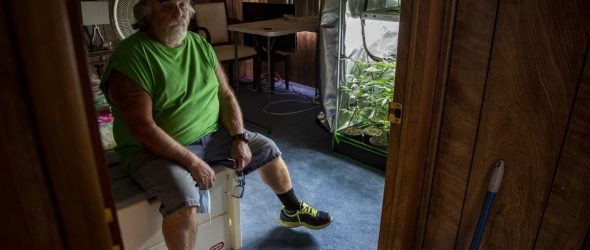 https://cannabisexaminers.com/wp-content/uploads/2020/07/la-photos-1staff-566090-me-0102-unlicensed-weed-farmers-21-gmf.jpg
https://cannabisexaminers.com/wp-content/uploads/2020/07/la-photos-1staff-566090-me-0102-unlicensed-weed-farmers-21-gmf.jpg
Ronnie Bell’s prized possessions aren’t the collectible toys or bongs that clutter his ranch-style house. What the 65-year-old values most is his extensive indoor marijuana grow.
Bell’s “bachelor pad” features a guest-bedroom-turned-nursery with a reflective grow-tent. There are racks of marijuana plants in the next room. This farmer, who served 21 years in the U.S. Marines and 21 years in the U.S. Postal Service, is one of many unlicensed marijuana cultivators in the unincorporated township of Anza.
Over the 24 years Bell has grown marijuana, he has been raided eight times and arrested seven. When he was arrested in May, Bell said, he suffered a torn rotator cuff. His old friend, marijuana, made the pain bearable.

Ronnie Bell smokes cannabis oil in his living room. The drug helps with back pain and a shoulder injury he suffered when deputies twisted his arm, Bell said.
(Gina Ferazzi / Los Angeles Times)
In the Inland Empire, Anza, population about 3,000, is a small place with a big reputation — when it comes to weed. If you smoked it and it didn’t come from a legal source, many locals said, it might well have come from Anza. Drive into town and it seems impossible to run into someone who can’t point you to a neighbor who grows cannabis; said pointer may grow it too.
The town has the optimal microclimate for marijuana cultivation; access to water, hot, dry summers. And the sale of cannabis supplements the income of people who might otherwise live below the poverty line.
Riverside County supervisors have so far shown little inclination to support the small, thriving marijuana growers of Anza. Meanwhile, the county Sheriff’s Department has conducted frequent raids in recent years.
“Illegal marijuana cultivation is harmful to the environment and community,” said sheriff’s Sgt. Albert Martinez. “The Riverside County Sheriff’s Department has responded to crimes of homicide, theft, robbery, kidnapping, the theft of utilities, illegal chemical waste dumping (which ends up in the water table) all associated with illegal grows.”
Since Proposition 64 took effect in 2017, California residents have been allowed to grow up to six plants. The year before, Riverside County passed an ordinance allowing qualified medical cannabis patients in unincorporated townships like Anza to grow 12 plants. For households with two qualified patients, the number doubles to 24. But Anza’s zoning prevents most from growing and selling cannabis.
So there’s nothing legal about Bell’s operation.
His small cannabis grow helps supplement his income and supplies him with medicinal marijuana to treat a back injury, Bell said, and the onset of a pandemic-caused recession has made his operation all the more essential.
“I’m just a peaceful farmer. I want to give this farm to my son one day,” Bell said. “I’ve put everything I’ve got into this. We’re not trying to make a million bucks, I’m just passionate about this plant and the people involved with it.”
For dozens of small growers in Anza, where the median household income sits at $41,200, the cannabis farms are crucial, said Edison Gomez-Krauss, a founding member of the High Country Grower’s Assn., which advocates for laxer cannabis cultivation laws.
The sprawling fields in Anza are home to more greenhouses than local merchants. Small markets, gas stations and the prized Dairy Queen are among the few signs of mainstream commerce. Farming is the town’s life force, and the smell of marijuana is omnipresent.
Mondays are nervous times for Bell. The Sheriff’s Department dubs them “Marijuana Mondays” because of the frequency of raids.
And so on Mondays, Bell’s attention is focused on the security cameras monitoring the front gate. One recent Monday saw him slowly stripping away at the skeleton of his two remaining greenhouses, which he said the Sheriff’s Department deemed a code violation.
On May 13, Bell was one of 10 people busted by the Sheriff’s Department. He was startled by the sound of deputies over a loudspeaker as they charged through his gate. As he headed to the front porch, he shrank away from the guns pointed in his direction, he said. Officers zip-tied his wrists, pulling his arms back farther than they could bend, he said. He watched investigators enter his house.
Bell heard crashing. Deputies slashed through greenhouses that cost about $6,000 each, kicked down lights and confiscated 10 pounds of weed, a generator and 1,898 plants, according to the Sheriff’s Department property report. He was slapped with a code enforcement violation for his greenhouses.
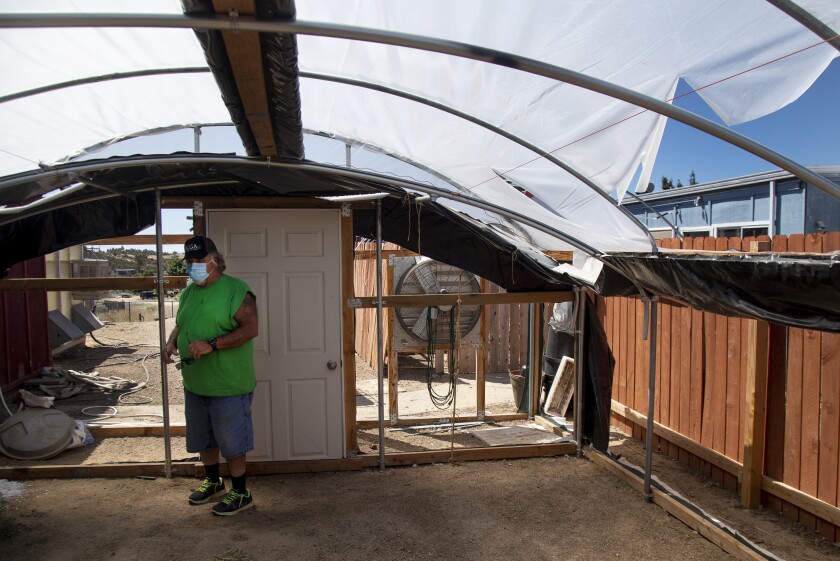
Ronnie Bell inside a greenhouse he said was damaged by Sheriff’s deputies during a raid.
(Gina Ferazzi / Los Angeles Times)
In total that day, authorities eradicated nearly 10,000 plants and collected 298 pounds of processed marijuana, according to Martinez.
Bell said he keeps half of the product he grows for personal medicinal use, and his son sells the other half to trusted black marketeers. Dubbed “OG Kush 371,” the plants are an homage to the road to Anza, Highway 371.
Shaken by the most recent raid, Bell grows on a smaller scale and dedicates his time to the 10-month cultivation process.
In March, he starts by planting seeds or cloning plants. After two months, his son or hired hands take the plants and move them into a greenhouse. By September or October, Bell harvests the plants and hangs them to dry for 10 days before starting the two-month trimming process.
When finished, he places the product into a nylon bag and uses a hydraulic press to create cannabis oil.
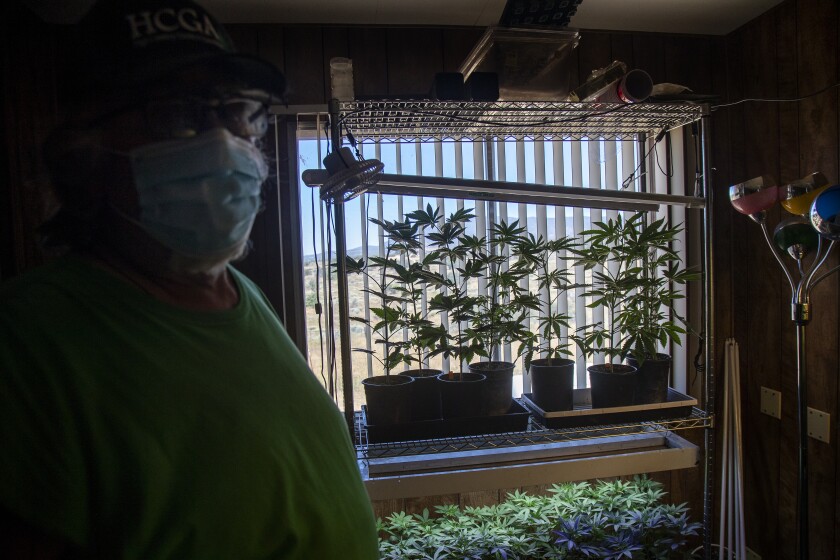
Despite raids and arrests by deputies, Bell continues to grow cannabis to supplement his income and supply himself for medicinal use.
(Gina Ferazzi / Los Angeles Times)
Most mornings he inspects each plant for blemishes or seeds — a sign that the plant would be unsalable — and sets the large carbon dioxide tank to 1,015 parts per million. The gas is directed through a series of tubes to a fan that blows it onto the plants for 12 hours a day. He makes sure the grow lights are set to stay on for 12 hours. He has perfected this setup to speed the growing process.
Years back, he also tended a larger indoor nursery that allowed him to harvest year-round. But now he spends more time raising baby chicks and fish.
Bell ran away from home at age 15, hitchhiking from Kansas City, Mo., to Anaheim.
“We was selling drugs and pills just to make enough to eat and stuff,” he said. “I didn’t have the best childhood. But eventually someone told us about a hippie commune up in Idyllwild, so we went.”
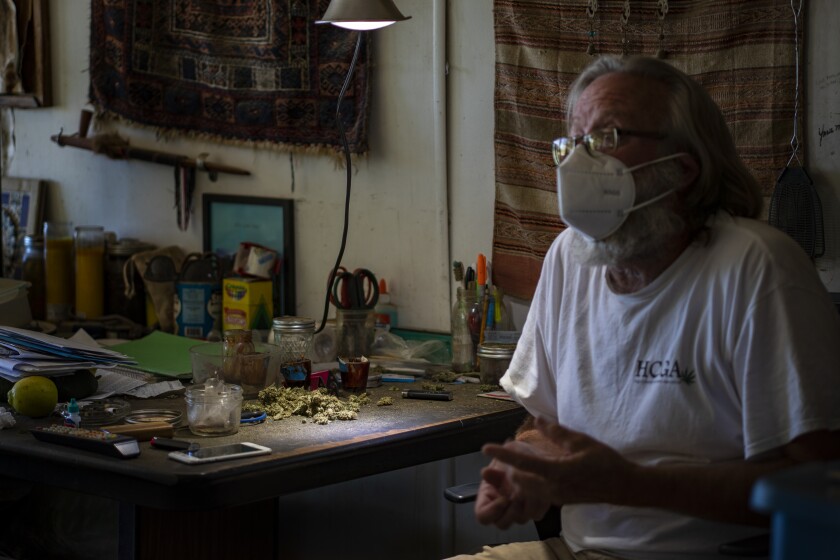
Kendall Steinmetz of Anza, Calif., at his living room table, where he trims his cannabis buds. Steinmetz, too, has had several run-ins with law enforcement, but continues to grow.
(Gina Ferazzi / Los Angeles Times)
Just across town, fellow HGCA founding member Kendall Steinmetz, 67, contemplates putting up plywood to surround his legal outdoor grow with a note that reads: “Civil forfeiture is unconstitutional.”
He starts the day at 9 a.m. trimming last year’s harvest — a laborious process that has taken him months — while watching the morning news. He smokes the first of 10 joints and checks on his outdoor plants and fruit trees.
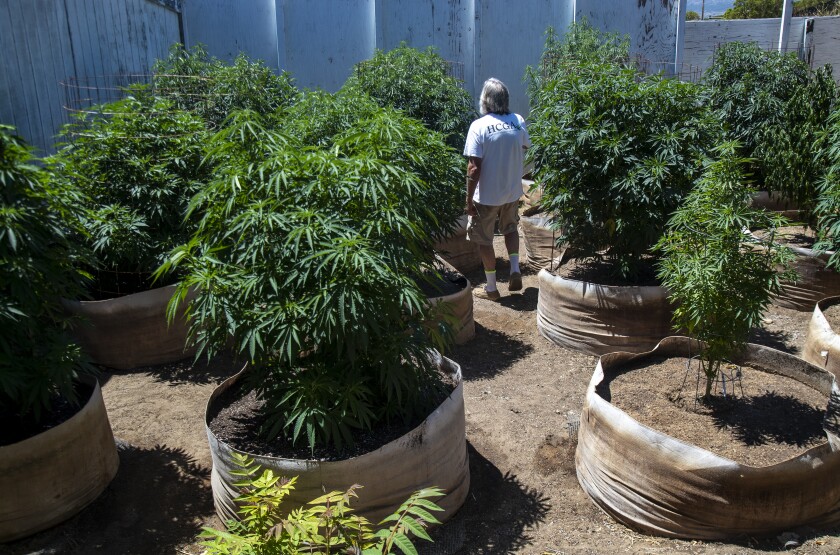
Kendall Steinmetz checks on his cannabis. “We’re like any other farmer,” he said, “We’re just passionate about our plants.”
(Gina Ferazzi / Los Angeles Times)
“We’re like any other farmer, we’re just passionate about our plants,” Steinmetz said.
Anza residents are divided on the issue of cannabis cultivation. While it has existed here for decades, legislation that has made enforcement less tough has led to tensions as the area became more attractive to prospective growers. In 2016, Take Back Anza was formed.
The group is concerned about the impacts of farming, including dips in water supply in the Santa Margarita Watershed, an increase in illegal operations and properties ruined by renters who leave after harvesting.
Take Back Anza founder Gary Worobec said men brandishing guns have occasionally blocked roads. Worobec said the group is focused on removing large, illegal grows. But small growers felt they have been targeted in the past.
In the last year, Martinez said, the Hemet sheriff’s station conducted or assisted in 31 raids, eradicating 163,704 plants and more than 41 tons of marijuana.
Martinez estimated $170 million in plants and processed marijuana were eradicated this year alone. The station will likely double 2019’s number of raids.
In their downtime, Bell and Steinmetz work with HCGA to propose alternative zoning policies to legalize small growing operations. According to a report by the Anza Valley Municipal Advisory Council, 97% of Anza residents live on rural residential or agricultural land, which prevents them from growing and selling cannabis but allows other commercial farming.
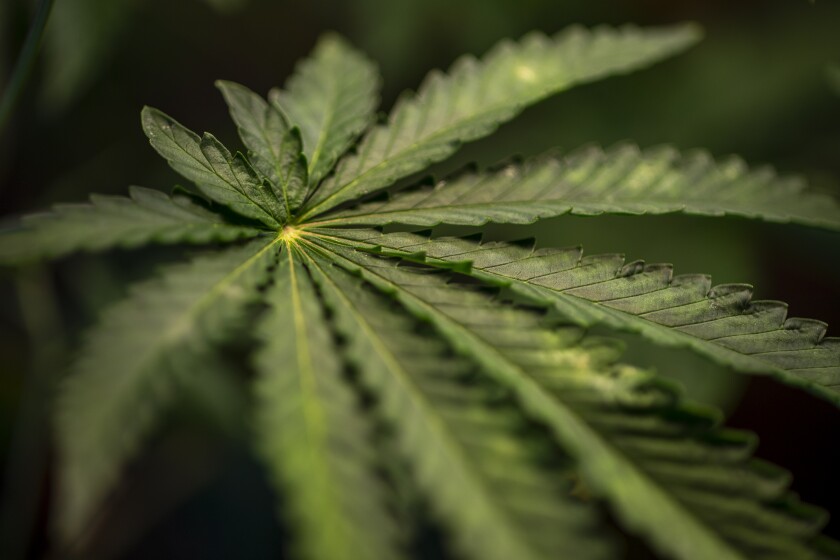
A close-up of one of Kendall Steinmetz’s cannabis plants.
(Gina Ferazzi / Los Angeles Times)
No permits have been granted to cannabis cultivators in Riverside County, said County Supervisor Chuck Washington, who oversees Anza Valley.
“Admittedly our process is overly burdensome for the small growers,” Washington said. “The licensing process by its nature … [is] bureaucratic. It becomes very expensive and out of reach. We haven’t figured out a way to manage that.”
For Bell and Steinmetz, attempting to fit in the legal framework is a trip in itself.
“This is the Napa Valley of marijuana cultivation,” Bell said. “So much revenue comes in from this plant, and we just want to positively contribute to the revenue stream in Anza. This town is asleep, and it’s begging for life.”

